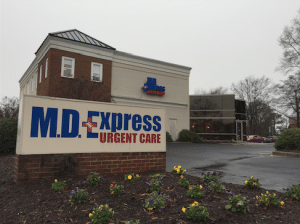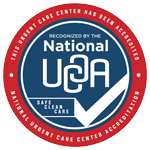
In many of these cases, a person might opt to see a primary care physician, if the swelling is not too bad and they can handle a short wait to get in to see him or her. Others may try the emergency room, sitting in a waiting room filled with other patients with more critical conditions, as they wait for a re-correction of the bone and a splint.
But there’s a third option, one that is gaining popularity in the past several years that you may not know much about.
It’s called urgent care. Here are four reasons why you should use urgent care when things may not require a trip to the emergency room.
1. Urgent Care Requires No Appointment
One of the more difficult issues with seeing a primary care physician is that you need an appointment, even for pressing issues. With urgent care, there is no need for an appointment. Patients are seen on a triage basis and generally within 30-45 minutes, according to statistics. This makes urgent care a smart option for treatment of minor issues.
The same “no appointment” option is true, of course, for the emergency room. They are designed for walk-in patients and treat the patients according to triage as well. But emergency rooms tend to have longer wait times and, as seen later in this list, are far more costly. Urgent care handles patients with all sorts of injuries–from minor to major–with a quicker response time than the emergency room.
And because there is no need for an appointment, it is a smart option for minor, pressing issues.
2. Many Urgent Care Centers Have a Qualified Team of Physicians
One major, beneficial factor of the primary care physician is that patients have a relationship with them, sometimes dating back years. They have all the patient history files, the recorded test results, the medications the patient is on and the doses. Opponents of urgent care might say that the urgent care physician is not experienced enough with the patient to treat them well.
But that’s patently incorrect.
Urgent care centers generally follow one of three models. The first is a physician-only model, where there are no mid-level providers. The other is a mixed-model, with a balance of physicians, physician assistants, and nurses, a model designed to handle a higher patient load. The mid-level model is staffed only with mid-level providers and handles only minor situations and cases.
The urgent care model is designed to treat immediate-need cases (broken bones, lacerations, bad bouts of influenza, bronchitis, migraines, and more) with accurate treatment to remedy the issue. With those three models, qualified physicians and nurses are staffed at these locations to handle issues.
Especially the minor ones.
3. Urgent Care Is Inexpensive
When faced with a decision to receive care at the emergency room or urgent care, a patient needs to be aware of two things: How serious their condition is and the cost of treatment. And with cost of treatment, urgent care beats the emergency room by quite a bit.
The statistics are amazing in their own right: the average emergency room visit is $2,200, while the average urgent care visit is $168, even for patients with the same diagnosis.
Although you likely wouldn’t go to the emergency room for a minor issue, it’s useful to underscore how affordable urgent care is compared to the ER. If you have a pressing issue, even a minor one, it may be tempting to go to the ER for treatment, and walk out healthy but with a two-thousand dollar bill.
This is likely a reason urgent care has become more popular. According to this study, patient visits to the ER with minor conditions dropped 36% from 2008-2015, with visits to non-emergent care facilities (like urgent care) jumping 140%.
It’s cheaper and the treatment is just as effective for minor healthcare issues.
4. The Wait Time Is Short
When you have a pressing issue, minor or major, it’s hard to just sit in a waiting room, watching as patient after patient gets called, and, like the example earlier, your finger is throbbing and swelling.
Fortunately, urgent care treatment has two components: Triage and speed.
According to Business Insider, of the 89 million patient visits seen in urgent care clinics, 85% are seen in less than an hour, with some urgent care centers seeing more than that in a shorter time span.
Urgent care centers rely on triage, meaning the most acute patient is seen first, with the second most acute patient seen second, and so forth. This means that if your throbbing finger beats the person with a mild case of the flu, you get to go first. Still, overall, patients are seen quickly, whether for minor or major issues.
Ending Note
Overall, urgent care centers have benefits over other forms of treatment. There is no need to make an appointment, centers have qualified teams to treat patients with minor and major issues, centers are inexpensive, and the wait time is short.
Consider visiting us at MD Express Urgent Care for minor issues.

